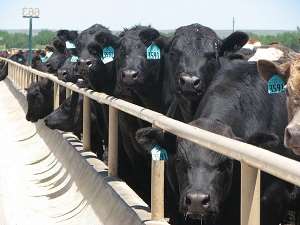By Dr. Derrell Peel, Oklahoma State University Extension Livestock Marketing Specialist

Mondays, Dr. Derrell Peel, Oklahoma State University Extension Livestock Marketing Specialist, offers his economic analysis of the beef cattle industry. This analysis is a part of the weekly series known as the "Cow Calf Corner" published electronically by Dr. Peel and Dr. Glenn Selk. Today, Dr. Peel reviews the prospects of the feeder cattle market this fall based on findings from the recent USDA Cattle on Feed report.
"Changes in feeder cattle prices recently have potential impacts for cow-calf and stocker producers this fall. Through July and August, prices for heavy feeder cattle have increased relative to lighter weight feeder cattle. Several factors appear to be impacting feeder cattle price relationships.
"The August USDA Cattle on Feed report shows an August 1 on-feed inventory of 10.165 million head, 101.6 percent of last year. July marketings were 99.3 percent of one year ago while placements were 101.6 percent of last year. With two less business days this year compared to 2015, these numbers suggest a continued brisk pace of both placements and marketings. The desire to increase feedlot turnover means that feedlots continue to demonstrate a preference for heavy feeder cattle. Since placements began increasing in February, placements of feeders over 700 pounds have increased over 11 percent year over year while placements of cattle under 600 pounds are down nearly 6 percent compared to the same six months last year.
"All else being equal, feedlots would generally rather feed bigger, older feeder cattle. Especially with continued heavy discounts on deferred live cattle futures, feedlots are less interested in buying lighter weight feeders and take the risk of owning them for a longer period of time. This is true despite the fact that feedlot cost of gain is decreasing with abundant grain supplies and the prospects for record grain crops for the coming year. Wheat prices and large supplies of relatively poor quality old crop wheat make wheat a ration alternative and the only reason it is not being used more is that corn is cheap and getting cheaper.
"Feedlots are constantly deciding whether to buy pounds by buying heavy feeder cattle or buying lighter weight feeders and putting the pounds on in the feedlot. Lower feedlot cost of gain means that feedlots can afford to pay more for lighter weight feeders. However, a growing supply of feeder cattle means that feedlots don’t have to buy light weight placements as long as an ample supply of heavy feeder is available to meet their preferences. This is a big part of the observed increase in heavy feeder cattle price relative to lightweight feeder cattle prices this summer. For steers, this is revealed as smaller rollback in prices across weights ranging from about 500 to 750 pounds. The smaller rollback results in an increase in the value of gain for those middle weight ranges of feeder cattle. In other words, the relatively smaller feedlot demand for lighter weight feeder cattle translates into a stocker/backgrounding signal to put that weight on in the country. Generally good forage conditions means that, despite falling grain prices, it is more efficient to put extra weight on cattle in the country, especially in the face of growing cattle supplies.